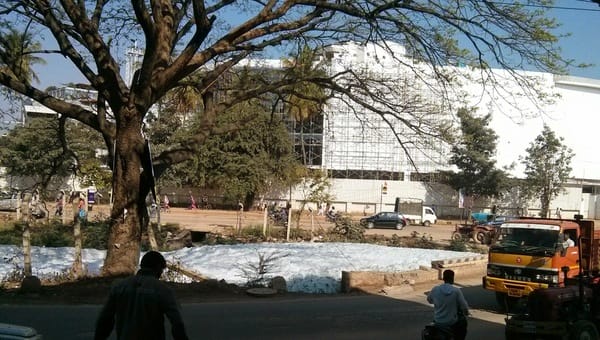
Pic: Rajesh Shah
Varthur and Bellandur lakes have been in the news over the past one year due to froth and fire. These lakes were last desilted in 1970. As part of the rejuvenation efforts, scientists from Indian Institute of Science (IISc) and other experts have been recommending wet dredging to remove the silt and sludge. To estimate the amount of silt and sludge that have accumulated over the years, Prof. Ramachandra of IISc recommended a bathymetric survey.
IISc and MEG Teams at KK English School
Citizens who took into consideration the recommendations of teh scientists seriously, joined their hands to fund the bathymetyric study, in the absence of government support. Whitefield Rising (WR) and Bellandur Lake Group requested Prof. Ramachandra and his team to help with the survey. He sought help with the necessary boats and people. After obtaining approval, Commandant of Madras Engineering Group (MEG) – an army wing – agreed to the request of Ambika Sen, Volunteer, WR, her husband Mr Sen, and Prof. Ramachandra.
A 13-member team of MEG reached Varthur with two boats on April 3. They set up camp at KK English School, where Mr Khan from KK English School and WR team extended hospitality to the MEG team and the five-member IISc team. This initiative would not have been possible without the support of the MEG team. The team worked undaunted by the heat and difficult situation on the ground. The team has been instrumental in Ulsoor Lake revival and maintenance.
Varthur to Bellandur
The survey and water sample collection commenced on April 4. The water hyacinth and weed cover made the task tough as the boats could not move far from the shore on April 5 for about 75 minutes. The scorching sun made life difficult as well with dehydration and other heat-related discomfort. The team completed the task at Varthur Lake on April 7 and moved to Bellandur Lake next day to set up camp there. The Bellandur Lake Group has been extending its hospitality to the MEG and IISc teams since then.
Community Support
Overwhelming response and support was seen from the residents around the Bellandur Lake in salvaging and restoring the lost glory of the lake. Shobha Community, Suncity Apartments, Genesis and Euphoria joined up for the drive to restore the lake. Apartments from Yemlur have joined to put pressure on authorities as they are victims to the famous chemical snow.
The community understands it is a long journey with a baby step towards the direction being the quality survey done by the MEG and IISC team. The community will extend its support to the state to salvage and restore the lake. Bellandur Lake being the largest lake in the city spread over approximately 900 acres is bed to flora and fauna and is a need of the society for ecological balance.
Related Articles
False promise to save Bellandur lake exposed
How govt helps SEZ trump Bellandur lake
All you need to know about Bellandur Lake and its problems
how do i get to meet members from whitefield rising